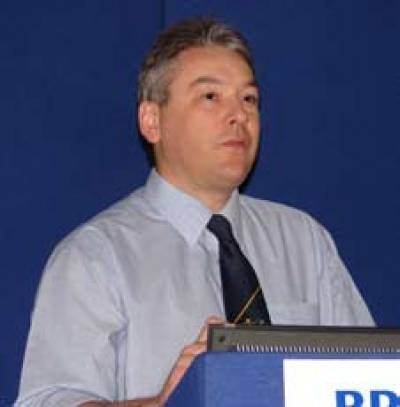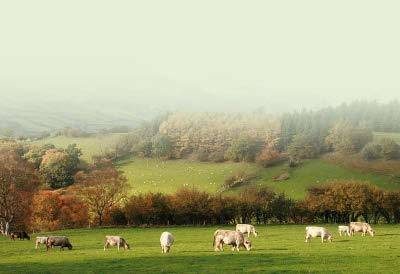Conference

When retiring Club chairman, Rob Wills, decided on the theme of 'A sustainable breeding future' for the January 2010 conference, he may not have imagined the diversity of interpretations his title would provoke.
In fact, it generated a whole raft of reactions, delivering conflicts and controversies between some parties present to the broadest of agreement amongst others. All took place in the most convivial of atmospheres, as record numbers of delegates - over 300 in all - enjoyed the opportunity to escape the daily grind; catch up with kindred spirits and keep abreast of developments in their particular field.
Repeatedly coming to the fore were the challenges facing the industry - in particular, the requirement to increase food production on the one hand while reducing emissions on the other. There were those who believed that grass-based production held the key in this process; and there were others who highlighted the growing importance of by-products, largely from the production of biofuels. But all were agreed, that cattle themselves had something special to offer in their remarkable capacity to turn the lowest grade of feeds into the highest quality protein - an ability to be cherished, nurtured and loudly proclaimed.
Then came the thorny matter of genomics, eschewed by a minority who feared for the faster development of genetic defects, but embraced by the majority of those who expressed a view. As a means by which to improve both efficiency and sustainability of beef and milk production, most were agreed that the UK needed the vision, investment and impetus to move its breeding industry into the new era.
With representation amongst the speakers from a broad cross-section of farmers; a major abattoir director; leading food retailers; and scientists at the cutting edge with new research to report, there was something to appeal to every delegate present.
The Club's thanks are extended to all who took part and maintained the usual level of informed and engaging discussion. And for those who were unable to attend, we are delighted to provide a taster of the conference in this Club newsletter, now newly incorporated into the enlarged 'Cattle Breeder'.
The British Cattle Conference was held in Telford in January 2010.
Ten year emissions plan will benefit from knowledge we already have

The greenhouse gases produced by cattle farming can be considerably reduced by applying the knowledge we already have.
This message from Duncan Pullar, head of R&D for EBLEX, got the 2010 British Cattle Conference off the ground and set the tone for the event in which optimism and a 'can do' attitude prevailed amongst the speakers and delegates. With targets to reduce farming's carbon footprint by 11% by 2020 as part of the UK Low Carbon Transition Plan, Dr Pullar said the industry was already on the path to this goal and that worthwhile improvements were possible.
"Emissions reduction in beef production needs to be based firmly on improving productive efficiency," he said, advising beef producers to identify their 'easier hits' which would vary according to system.
Improving feeding efficiency offered markedly greater emissions reduction benefits than improving either the fertility or longevity of breeding stock, but improvements in all of these areas could make important contributions to the overall reduction.
Feed which was more digestible produced less methane (one of the most important greenhouse gases (GHGs) in cattle production), such that sward heights could be managed more effectively and conserved to give optimum Metabolizable Energy (ME) values. Similarly, grass varieties could be selected for higher sugar content and clovers for lower protein, so avoiding waste.
Feed efficiency was also heritable, according to Dr Pullar, which meant breeders should continue to select for efficiency and productivity as well as traits like fertility, longevity and disease resistance.
"Overall, the arguments almost completely overlap with those for economic efficiency," said Dr Pullar, who also observed that the past 10 years had already seen steady improvements, with five% fewer prime cattle required in 2008 to produce each tonne of beef than in 1998.
"This, and the progressive reduction in both breeding and slaughter stock numbers over the past 10 years has undoubtedly contributed to substantial reductions in GHG emissions recorded in recent years," said Dr Pullar.
Dairy beef produced fewer GHGs than beef from a suckler herd, partly because overhead costs of the cow were assigned to milk production, while extensification tended to increase global warming potential per kg of beef.
"This is because more animals are required to produce each tonne of beef and lower quality forages tend to generate higher methane emissions," said Dr Pullar.
However, 60% of the UK's farmland is only suitable for growing grass and hence not suitable for the production of human food unless a ruminant is used as the 'vehicle', and reducing production from such areas would simply export the problem because we are net importers of beef.
"It's a balance between what's possible and what's sociologically acceptable," said Dr Pullar. "And just because only eight% of people consider GHGs when buying meat does not mean we should ignore the problem."
Instead, he said the industry had time to respond, to marshal its arguments, and to robustly defend its position.
Buyers should know TB history of herd

Farmers buying in livestock should focus far more closely on the TB history of the herd from which they're buying than on the geographical location of the farm. Such an approach would be the most likely to avoid the import of bovine TB.
Questions needed to be asked, according to Lancashire vet, Carl Padgett, such as how long had the herd been clear of bovine TB or what time had elapsed since the last test.
"If the herd has only just regained it OTF [officially tuberculosis free] status, there could be false negative animals seeding infection and there could be more risk if trading with this herd," said Mr Padgett.
However, if more time had passed since the negative test, the risk of trading would generally be lower. However, a herd which had not been tested for nearly four years could also harbour problems.
"Consider whether you want to accept the risks presented by herds engaged in high risk practices," said Mr Padgett, giving flying herds or those with a lot of animal movements through the farm as examples. "And base your decision on herd practices rather than region."
Commodity versus specialist beef

Aberdeen Angus producer, David Ismail believed that a sustainable breeding future hinged on economic success, and had set about achieving this across 4,500 acres of Perthshire by producing quality rather than commodity beef.
Running Europe's largest pedigree Angus herd, predominantly under an organic system, he explained how he wanted moderate-framed cows which were able to survive in difficult conditions.
Regretting the fact that many Angus breeders had lost all of their original bloodlines and continued to breed for size and muscling, he believed the emphasis would be better placed on traits such as tenderness and marbling.
Without this focus, he said that lean red meat was just a commodity and that one day, trade barriers would be gone and the UK would need to find a way to compete on the international stage.
Selling his own product to the premium markets including Harrods and Selfridges, he had also brought the Japanese Wagu breed into his herd - initially as a stand-alone breed but potentially to cross with the Angus - which would produce the highly marbled and tender beef containing a far healthier complement of unsaturated (oleic) fats than traditional breeds. Lancashire farmer, Phil Halhead's take on the issue of sustainability took him to the oppostite extreme, believing that intensification and even possibly industrialization held the key to the industry's future.
His own 200 Holsteins had replacements bred from sexed female dairy semen, leaving some 80 per cent of the herd to be put to a British Blue. Finishing these at around 600kg at 14-15 months and killing out at an average 64-65%, he believed that his was a formula for minimising the system's carbon footprint and maximising its efficiency.
Whilst recognising 'the very successful few who have skilfully developed niche markets', he believed that an efficient, dairy beef system would minimise environmental overheads and produce consistent and quality beef at affordable prices, while retaining a return for the producer.
Breeding beef for better human health with higher Omega-3

Evidence of genetic differences in the fat composition in beef means there is the scope to change that composition through breeding. This could lead to an increase in polyunsaturated fatty acids, in particular Omega-3, which would have beneficial effects on human health - especially obesity and cardiovascular disease - and strengthen the market position of the beef industry.
This message from Professor in animal breeding, Rainer Roehe, followed recent research he had undertaken at SAC, which demonstrated cheap and accurate ways to measure the fatty acid profiles of beef carcasses in the abattoir, without king samples of meat.
This technology could potentially enable records for thousands of beef cattle to be collected, and so provide the reference population which would be needed to improve these traits through genomic selection.
"In our meat quality study, polyunsaturated fatty acids also showed positive phenotypic correlations with sensory characteristics," said Prof Roehe, indicating that juiciness as well as flavour and tenderness improved as the desirable fats increased.
Because of this, he said that simultaneous genetic improvement of all these traits could be achieved.
He also advised that genetic improvement was a cost-effective approach to improving beef's fat profile, since it was cumulative and could potentially be spread over an entire population.
However, any genetic improvement programmes had to consider the correlations between the fatty acid profiles and other traits such as growth rate, ultrasonic fat and muscle depth, feed efficiency and maternal traits, in order to improve the total profit of beef production. Some of these correlations had not yet been studied.
Further complexities would exist because of dietary influence on fatty acid profiles, said Dr Roehe.
Collect and share data or miss the real opportunity
Cattle genomics was a hot topic throughout the conference, with more than one speaker alluding to the UK's position in relation to the world leaders.
Jerry Taylor, who's at the cutting edge of genomics technology as Professor in animal genomics at the University of Missouri, said the U K would be 'coming from behind', and would be 'hard-pressed' to assemble the population sizes necessary to develop highly accurate molecular EBVs (Estimated Breeding Values) for its beef and dairy industries.
Repositories of both cattle DNA and their phenotypic measurements were urgently needed, and each country alone - even the USA, with its large cattle populations and as the first country in the world to officially publish genomically enhanced breeding values for Holsteins - would struggle to create a repository of sufficient scale to make worthwhile commercial use of the latest technology.
This applied particularly to the beef breeds, which were smaller in number than the Holstein, and raised the pressing need for international collaboration.
Suggesting that the execution of leading-edge genomic technology was being hamstrung by as basic a function as data and DNA collection, Professor Taylor said that the means existed to compute EBVs with at least 80% accuracy, and to double the rate of genetic progress.
"Much has been promised from genomics over the past 15 years," he said. "But finally the technology has come of age".
The imminent availability of new, high density SNP (single nucleotide polymorphism) chips (colloquially known as snip-chips) would far more reliably predict a variety of traits than possible using the current tests. The new tests would measure some 700-800,000 SNPs (compared with around 50,000 for the current chip) and could enable breeding values to be reliably estimated for traits such as feed efficiency and disease resistance. Most importantly, they could also open the way for genomic selection to be effective across all beef or dairy breeds, which would be particularly important for minority breeds which would struggle to accrue a sufficiently large 'reference population' of their own.
"The technology is now perfectly suited to estimate the genetic merit for any trait on which we have a significant number of animals with data," said Prof Taylor.
But the important challenge now was to assemble large test populations of both dairy and beef breeds, with phenotypes measured that are of importance to the industry. This includes those that were routinely recorded, but new phenotypes for traits such as feed intake and disease resistance or tolerance should also be recorded.
Citing the Aberdeen Angus breed society in the USA, as well as a variety of AI organisations as assisting the development and leading the uptake of the technology, he said that building a repository should not be down to the scientists and that levy funds should be diverted to this cause.
Urging a collaborative approach, he said: "We face the same issues internationally, and will be far better off working as a united force than being myopic and secular, if we are to ensure the cattle industry survives and retains a competitive edge over say poultry or pork.
"The reality is that we can bring molecular EBVs to the market with low accuracy but isn't it better to have higher accuracy and share the intellectual property as well as the royalty streams?
"Many people think they have valuable intellectual property but I hope it's possible to use history to convince people that if they are not prepared to share it, they may be missing the real opportunity.
"They can have a large slice of a small pie or take a smaller slice of something truly international and worthwhile."
This he suggested, could begin with steps as basic as taking and banking DNA at the time of an animal's registration and asking breeders to look in their flasks for old genetics.
Genomic proofs now widely accepted in Ireland
Donagh Berry from TEAGASC (Ireland's agriculture and food development authority) surprised many of the delegates at the conference by stating that Ireland had been the second country in the world (after the USA) to officially publish genomic breeding values for Holsteins and that the procedures which put this in train had begun in 2007 with exactly the process Prof Taylor had described (see opposite). "We started with a E2,000 grant from the Department of Agriculture," explained Dr Berry, "and that allowed us to buy the semen flasks which initially became the national DNA databank."
With farmers being paid €30 to supply some of the older or more difficult-to-acquire bulls from their tanks, and each animal's DNA information related to its performance data, it took less than two years for the first official genomic breeding values to be published, in February 2009.
Collaboration also took place with Switzerland and New Zealand and the work progressed rapidly; high correlations between genomic and progeny proofs were reported (0.77 for milk, 0.73 for fat and 0.77 for protein - where 1 is a perfect correlation and 0 is no correlation at all); and the reliability of genomic proofs rose to around 50%.
Farmer acceptance of the genomic proofs was said to be high, although this was attributed not simply to their confidence in the figures, but also to the lack of alternative choice.
"Apart from Oman and Ramos, there was nothing there," said Dr Berry, referring to two of the highest indexed progeny-proven bulls on the market. "Yes, there was risk involved, but the pricing was competitive, and the AI companies sold the bulls as teams, such as high fertility, high protein and easy calving teams."
The upshot was that 35% of Holstein Friesian semen sold in Ireland last year was from bulls with genomic evaluations, although some of these were 'lay-off' bulls which were brought back on to the market.
Much of the scheme's success to date was attributed to the existence of just one database to store all milk and performance records as well as DNA data, held by the ICBF (Irish Cattle Breeding Federation). This body has breed societies, milk recording organisations, AI companies and farmer organisations as its member shareholders, and has received EU structural as well as national government funding.
Such collaboration also meant that the industry collectively owned the intellectual property associated with the technology.
For the UK, Dr Berry said: "I'd advise you to generate a DNA bank owned by a national body for all dairy and beef sires and measure as many traits as you possibly can.
"You are not too late but you need to get in there now," he urged, adding that Ireland was keen to swap genotypes with other countries around the world and would willingly share its genomic information with the UK.
Stating that Ireland's relatively small scale (with little over one million head each of dairy and beef cattle) had helped the scheme get off the ground, he said that the UK appeared to have been stifled by politics.
"Leave the politics at the door," he urged, "as if you stay the way you are, you are going to miss the boat."
The role of pedigree and recording will change

The role of pedigree recording was called into question during the genomics debate, with Prof Taylor suggesting that pedigree information would not be needed to compute breeding values.
"I'm not recommending that it isn't collected as I think breeders like to know an animal's lineage," he said. "But genomic selection does not require a knowledge of genealogy. DNA markers actually construct relationships in a more reliable way than pedigree records. For example, the pedigree information tells us that a father and son share half their DNA, but genotyping tells us which half they share.
"In other words, it's possible to accurately estimate what parts of DNA were transmitted to the progeny, and pedigree knowledge can augment that information."
Commenting on the future for breed societies, he believed their role would change, and cited the Angus Society in the USA which had taken on board the technology and were curating and commercialising the data.
But Prof Taylor as well as other speakers on the subject - including Donagh Berry and Huub to Plate - were insistent that accurate recording of phenotype became more important than ever in the post-genomics world.
"Measure everything you possibly can," advised Dr Berry, who observed that the industry had selected heavily for milk production 10 years ago, and now had a problem with fertility.
"Is there another problem brewing which we are not recording?" he questioned. "Something like resistance to TB or Johne's or anything else? Chances are there is."
Observing that the industry would move in its chosen breeding direction whatever means was taken, he said: "If you end up going downhill, genomic evaluations will take you there faster."
Huub to Plate concurred with the need for more phenotypic recording and said: "I think farmers will collect more information which will be used in an evolving system which combines the old and the new to add more value for the farmer."
Conference delegate, Mike Coffey, from SAC, added: "I would encourage all farmers to record as many traits as accurately as they can as you never know to what use that information could be put in the future."
Succinctly summing up the debate, he concluded: "In the age of genotype, phenotype is king."
Genomic sceptic fears genetic defects
The genomic sceptics were given a voice at the conference, which came largely in the form of Gerard Scheepens from AI company, KI Samen of the Netherlands.
Raising a variety of objections, his first concern related to the potentially reduced generation interval attainable through the technology, in relation to the time taken for genetic defects to become apparent.
"Look at BLAD [Bovine Leukocyte Adhesion Deficiency]," said Mr Scheepens. "It was discovered in 1990 but was traced back to the earliest known carrier in 1952."
Similarly, CVM (Complex Vertebral Malformation) was discovered in 2000 and traced to a carrier from 1963. Using the technology of genomics and the reduced generation intervals that would ensue, he said that around 24 generations of cattle would have been bred before such defects came to light.
Arguing that it was better to progress at a slower pace and be aware of what was happening, he went on to refer to the constantly changing breeding goals to which each different country aspired.
Although accepting that the UK's Profitable Lifetime Index (PLI) was very close to the national indexes in the USA, Canada, Germany and the Netherlands, he said that every few years these indexes changed and it was very difficult to achieve the ideal.
Also highlighting the uncertainties of breeding, he said: "Never has the highest bull given us the new generation leader."
Although accepting that genomics may have something to offer the industry, he believed that claims had been overstated. He humorously encapsulated his sentiments on each of his slides, on which a naked emperor appeared. Most delegates agreed with the need to proceed with caution, but Mike Coffey from SAC added: "AI companies are managing risk all the time. This is simply a new technology that will enable them to proceed faster and with a known amount of risk. I don't see a great difference."
However, Somerset farmer, Mary Mead congratulated Mr Scheepens, expressed concern for the future of the dairy cow and asked what had happened to the survival of the fittest.
First progeny proofs from genomic bulls build confidence in system
Confidence in genomic evaluations was said to be growing in the USA since the recent publication of the first progeny proof figures for bulls with early genomic evaluations. These progeny-based figures far more closely reflected the animal's genomic evaluation than the parent average information, which would formerly have been the first available genetic prediction.
This message came from Huub to Plate, from US AI company CRI, 40% of whose semen sales were now accounted for by bulls with a genomically enhanced evaluation, which would grow to 50% by the end of 2010.
This level of uptake he said even surprised the company, which had been expecting an uptake of closer to 25% in the first year.
The reason for their popularity he said was far better quality genetics than the available proven sires, although this had to be weighed against the lower reliability of the genomic proof. However, genomically enhanced indexes were generally 24 to 50% more reliable than parent average proofs although for some traits, could rise to as much as 85%, despite the animal having no milking daughters.
The better quality genetics could be seen in an analysis of daughter-proven against genomic sires which showed a superiority of 372lbs Predicting Transmitting Ability for milk, 25lbs PTA fat, 14lbs PTA protein and 1.27 points for PTA for type in the group of genomically evaluated sires (US figures).
And when these genomically evaluated bulls gained their first daughter proofs from milking and type classified daughters, although there was a slight drop in their figures, they still retained their considerable genetic advantage.
The correlation between their new actual proof and their earlier genomic proof was far higher (0.62, 0.70 and 0.63 for milk, fat and protein respectively) than the correlation between their actual proof and their proof based on parent average (0.44, 0.54 and 0.48). This should be seen in the context of a perfect correlation being one and a correlation of zero indicating no association at all. "This is what we expected but it is great to see it works," said Mr to Plate. "The correlation is not one, so we don't have a perfect system, just as we do not have a perfect system based on first crop daughter proofs."
In fact, he said that one and two-year-old bulls' genomic evaluations were as accurate as five-year-old bulls with early first crop daughters.
And because bulls with a genomic evaluation could be used from one year of age onwards, there was scope to increase the rate of genetic improvement by 50%.
But he added: "There is a trade off in higher proofs from younger bulls and lower reliability. Risk management is required."
But genomics would improve in reliability as the technology developed.
Health and fitness indexes are central to herd's economic success
Dorset farmer, Tom King, believes that selection for health and fitness traits is bringing significant benefits to his cows and the economic success of his business. His high yielding herd of Holsteins, which he runs with his father, Alan, achieves average production of 11,632kg at 3.89% fat and 3.03% protein, and has 72% of cows classified Very Good or Excellent. It also has an average Profitable Lifetime Index of £80, placing it in the top one% in the UK.
But speaking at the conference, Mr King explained that he had neither bred for high PLI nor for high overall type. In fact, the process of selecting AI sires involved an initial filtering out of bulls with poor Lifespan, SCC and Fertility Index, and picking the best from this shortlist for production, components and the functional traits of legs, feet and udders.
The results on the farm he said were clear to see. "The fitness indexes are strongly linked with what we see in the cows and when we do an analysis of the herd, it's no surprise that the highest cell count cows are the daughters of the high cell count bulls," he said.
Of the 14 cows to have most recently had mastitis in his herd, he said that 12 were by bulls with SCC Indexes higher than
zero. Such bulls would now be generally filtered out of the system. Similarly, he cited a strong link between a bull's Fertility Index (FI) and the cows' actual performance, and said that daughters of top PLI and good FI sire, Oman (0-Bee Manfred Justice) were averaging 80% conception rates, whereas daughters of a bull with a FI of -15 had conception rates of around 25%.
Describing how he had used the fitness and management indexes since they were first introduced, he said: "We have used them heavily because we are absolutely convinced that they work. And the more we use them, the more we believe in them."
Herd cell counts averaging 70,000 cells/ml supported this view, while calving index, currently standing at 406 days, is the next target for improvement.
Convinced of the need to continue to focus on genetic improvement and particularly on Fertility Index, he said: "If your cows are better genetically, it makes them far easier to manage."
Breeding efficient cows improves their greenhouse gas emissions
Breeding dairy cows for overall efficiency will have a positive impact on their greenhouse gas emissions. This could mean that by selecting larger and faster-growing breeds whose energy intake is more efficiently converted into milk (or meat), greenhouse gas (GHG) emissions are reduced, per unit of food produced.
In delivering her message at the conference, SAC scientist Eileen Wall said that genetic improvement was a particularly cost-effective technology, producing permanent and cumulative changes in performance, and that there was no reason why an environmental selection index could not be developed for dairy cows.
When selection indexes such as £PLI (Profitable Lifetime Index) were developed, a 'relative economic value' (REV) was applied to each of its components.
A similar model used to develop REVS could also be used to develop 'relative environmental values' which could lead on to the development of an environmental selection index.
However, she noted that it was difficult to accurately measure GHGs produced by cattle and added: "As with all indexes using weightings other than those based on expected market values, such indexes may produce suboptimal profitability for producers."
But selection for efficient production had clear benefits in mitigating emissions assured Dr Wall and would be a good approach for any milk producer.
For example, higher productivity in general leads to higher gross efficiency (converting feed into milk) because maintenance costs were diluted. This meant that a given level of production could be achieved with fewer but higher yielding animals and their followers.
But breeding for improved fitness - such as lifespan, health and fertility - also helped reduce emissions by reducing wastage of animals, said Dr Wall. Improving lifespan reduced the number of followers required to maintain the herd at a given size, and improving fertility reduced calving interval and the length of unproductive periods which in turn reduced management costs as well as emissions.
Carbon is one of many considerations when sourcing M & S beef
The retailer's perspective was put by Steve McLean, agriculture manager for Marks and Spencer, who believed that low carbon beef was fundamental to securing the future of the industry and that beef's carbon footprint was an increasing concern to the consumer.
"I agree with Duncan [Pullar] that eight per cent have concerns about beef's carbon footprint but this is rocketing and comes from a very low base," said Mr McLean. However, tools such as carbon calculators had to be standardised across the industry as widely variable results were leading to false claims.
The retailer's own food strategy was driven above all by the need to be unique and to differentiate its products, and procurement strategy was focussed on quality and provenance over price. An approved breeds list reflected the drive for product differentiation as well as consistency while strategic partnerships and breeding groups were all part of the picture. Citing the company's own breed of Oakham chicken, he said there was no reason why similar breed exclusivity could not apply to other sectors including beef.
However, although all beef for M&S UK stores was sourced in the UK, he said that other foods were sourced world-wide, for the best choice of product.
"Food security as a retailer does not mean buying everything in Great Britain, as having all eggs in one basket could worsen the situation," said Mr McLean.
Red meat sales he said had proved most vulnerable during the recession, but discounting prices had helped maintain the volume sold.
With 46% of M&S business accounted for by food, equating to sales of £9 billion last year, he said there was currently no capacity to increase the consumer spend on food. However, M&S had an unusually loyal customer base, and just 15% of the footfall accounted for 55% of the take.
Other issues of concern to the company included water and embedded water within food products as well as animal welfare, traceability and human health and nutrition including reducing the saturated fat in beef.
And while animal welfare remained important to consumers at times of recession, he said that how the company looked after its farmers appeared to go 'out of the window' for the consumer in difficult times.
Cattle industry must 'get out and shout'
There's a very positive message to come from the cattle industry, which should 'get out and shout about it, rather than bury its head in the sand. This message came from Stuart Roberts, director of Midlands-based Anglo Beef Processors, who described livestock farming as 'the new aviation industry' which was being 'knocked from all quarters, even an ex-Beatle'.
"The industry has a duty to sell some of the positive messages as well as address the negatives," said Mr Roberts, who added that the vegan and vegetarian lobby were powerful groups who were using the environment as another weapon of attack.
Addressing the issue of sustainability, he said that the word was over-used by too many people, each of whom had a different meaning for it.
"For too many people it's just about the environment," he said. "But for me, it's a much bigger issue covering social, environmental and economic sustainability.
"We need to recognise our environmental impact," said Mr Roberts. "We contribute, but we are not the sole cause. "And we need to recognise the significant differences between grass-based and cereal-based systems." Describing the countryside as 'artificial' and continuing
to evolve, he said that livestock played an important role in habitat management.
"The countryside that the public want is a consequence of economic and sustainable farming over the years," he said, adding that livestock played an important part in the management of permanent pasture, which was crucial in locking up carbon.
And the argument that putting livestock land into crops led to more efficient food production, overlooked both the carbon released by ploughing and the fact that much of the land was unploughable.
Livestock farming he said took very indigestible feed and turned it into 'the highest grade of protein known to man'. "As the world gets richer, it will want more and more of that top class protein," said Mr Roberts.
His optimism for increased beef demand was reinforced by higher numbers processed last year by his company - which is one of the largest beef processors in Europe and handles over 300,000 cattle per year in the UK.
Meat was a valuable component of the diet and despite a temporary dip, the long-term trend would be for more consumption of higher value meat, he believed.